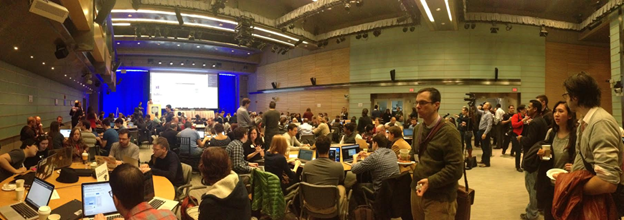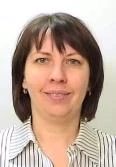The power of open data to bring together people from different streams of life for civic purposes was on full display around the world on February 22-23, 2014. Washington, D.C. was home to one of the 194 global International Open Data Day events that dotted cities around the world. Data was scraped. Visualizations were made. Code was written. Interfaces were designed. Prototypes were built. Initiatives were born (Here’s looking at you, Code for Nepal!). New friends were made. And a tooth was chipped.
Despite the unseasonably warm weather in Washington, D.C., more than 350 civic hackers, development specialists, coders, designers, and enthusiasts participated in two days of Open Data Day hacking and tutorials at the World Bank. Based on an informal poll (raise your hand, please?!) of all attendees at the beginning of the event, nearly two-thirds of the audience had never attended an Open Data Day event before. This was an unexpected but welcome surprise and bodes well for the continued growth of the open data community in Washington, DC.
Admittedly, growing numbers are not the end goal of open data efforts, but one cannot deny the energy, enthusiasm, and new approaches that open data has brought to many important civic challenges both locally and internationally. As the expectations around open data and hackathons evolve, reaching the promised land of positive impact in our local communities and the world will require more inclusive and collaborative efforts. What does open data mean to you? Open data may mean different things to different people, but its ability to break down traditional social barriers has been demonstrated time and time again. Carrying the hype, the open data journey (and momentum) continues.
Serendipity- the children are our future
In the inclusive and innovative spirit of open data, there were also impromptu and unexpected gatherings, including a children’s tutorial on “happiness” index data led by Harshil Parikh of TuvaLabs, a platform that uses open data to increase data literacy.
Onward, Growing Community
So what’s next?
It is clear that the demand for open data and skills to leverage open data are on the rise. And it’s ok to come away from an event like this with more questions than answers.
Like many of life’s celebratory moments (i.e. graduation, a wedding, the birth of a child), Open Data Day marks a joyous beginning, not an end. Progress continues through new and renewed relationships and collaboration on projects, leveraging ongoing communities and meetups like Code for DC.
This is not to understate what was accomplished during Open Data Day itself. A list of what the project teams produced during our time together during Open Data Day events follows. Additionally, all the projects and presentations can be accessed through the following links: Project Plans List & Open Data Day DC Tumblr.
Diverse Projects & Challenges
As expected, given the location, a dynamic array of projects naturally formed around issues touching the immediate locale and more broadly focused on international development. Many groups pushed through the two days on topics of importance and significance:
- Philippines Road Safety & Transit Data Hack - With a delegation from the Philippines in attendance, this group used data to develop a road accident visualization platform and created visualizations showing transit route redundancies, exploring the relationship between transit route density and accidents in Metro Manila, and showing areas with the highest likelihood of accidents.

- Drugs, Corruption, and Data - An interesting project exploring the impact of counterfeit drug busts in Tanzania on HIV rates through demographic and health surveys (DHS) and AIDS Indicator surveys (AIS).
- Corruption: is there a clue in the data? - An impressive array of procurement and contract award data was identified and logged into a spreadsheet that categorizes the information contained in each respective source. The sites and data were ranked according to international development lending over the last five years, Transparency International’s Corruption Perception Index, and a scale measuring ease of use and utility of data. Some initial analysis of the data was conducted, and sample interfaces for interacting with data sources were also developed. The team from INT intends to add this data to the World Bank's public data set of major contract awards, as well as similar open data sets from other MDBs, to identify and analyze potential red flags in contract award patterns. The team also tapped into the World Bank data site to access population figures, Gross National Income, and other data, to prioritize the list of countries for closer examination.

- Mapping Scanned Documents (Liberating PDFs)- In addition to exchanging experiences working with various PDFs, this group also had a message for all data publishers: “Please don’t publish in PDF!”
- Mapping Human Conflict & Development Interventions - This project used mapping to explore the relationship between conflict and development interventions. The team focused on Nigeria, visualized data, and also arrived at a number of ways to take the project forward, including the creation of heat maps of violence as a good estimate for fatalities and features to help make better sense of the data being presented (sliders, color schemes, sector breakdowns, and labels).

- OpenDataDirectory – More than 90 data domains were compiled into a listing and a slick front-end design for the directory was created. This project will continue at the next Code for DC meeting!
- DC Municipal Regulations - Making regulations more accessible and understandable is a sizeable task, and this project worked to make DC’s municipal regulations more identifiable and useable. Roughly 98% of these regulations were imported and converted to a more useful format.
- Open Budgets- Anyone who has worked with financial data knows how difficult it can be. This team assessed existing tools for analyzing and presenting budget data, identified gaps and unmet needs, and put together a starter list of datasets that can be combined with budget data to provide more context and clarity.
- Practical Open Data for Nepal - This project scraped and cleaned shape files for 75 subnational districts in Nepal and put them out in open format for re-use, built a prototype app ranking schools, and visualized election data showing gender breakdowns. Along the way, a new initiative was launched. Congratulations Code for Nepal!

- DC Education - A force to be reckoned with, this team came out ready to use data in a variety of ways to advance the state of education in Washington DC. Among many accomplishments, the team created a “school-chooser” app and visualized “feeder pattern” data to show which schools children came from and their actual destination school.

- Mapping Extractive Industries in Nigeria - Aiming to ensure greater accountability of the oil industry in Nigeria, the team mapped pipelines and parts of the oil infrastructure. Specific spill sites were explored, tagged, and cross-checked with other data sources.

Thanks to all who joined us at the World Bank this year- please share your experience of the event and also any ideas on how this can be improved in 2015! See you next year at Open Data Day DC, and hopefully before then…
A warm thanks from the World Bank Open Finances team to our fellow co-organizers Josh Tauberer (GovTrack), Eric Mill (Sunlight Foundation), and Kat Townsend (USAID)!
World Bank Group Finances is the online access point for IBRD, IDA, and IFC open financial data. The website features datasets that cover loans, contracts, trust funds, investments, and financial statements. A related mobile app, which allows you to “talk” to us more easily about operational and financial data in nine languages, is available for download for Android and iOS smartphone and tablet users at the Google Store and the iTunes Store, respectively. Follow us on Twitter to join and remain engaged in the conversation about the Bank’s open financial data.





Join the Conversation